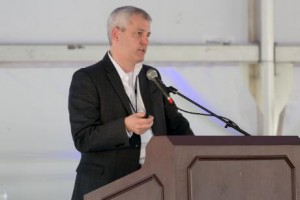August 2015, Vol. 242, No. 8
Features
ROSEN Sponsors Roundtable on Linear Threats

The ROSEN Group brought key industry stakeholders together for a roundtable on the topic of “Linear Threats in Pipelines” on May 28. The event attracted over 100 attendees from throughout North America and Europe who were hosted at the ROSEN facility in Gahanna, OH.
The roundtable began with an official welcome by ROSEN Executive Vice President Chris F. Yoxall, who emphasized the importance of “why we are here.” He addressed the goal and set the tone for the day – bringing together all stakeholders to collectively work on common topics of interest.
The keynote address from the company president and founder, Hermann Rosen, emphasized the need of being proactive by undertaking preventative measures to mitigate or minimize the effect of consequence management. Recognizing complexity, Rosen compared the human body to a pipeline network, saying without good integrity management, failures can occur with unwanted consequence.
“Whether we talk about the pipeline network, an aircraft or the human body there are a lot of similarities,” he said. “We are talking about different diameters, flow rates, gravity, pressure, debris, scale, wall thickness, as well as valves and y-pieces, reductions, lifetime. There is a lot in common. If the integrity of such a system fails to due blockage, leakage or rupture, this will cause a disaster, for example, a heart attack.”
Rosen recognized three groups of stakeholders, each having accountability – those involved in generating rules, the operators, and those proving technologies or services. In the short-term, these groups are all driven by performance indicators, while in the mid-term there has been more of a direction toward better alignment. In the long-term, there is a need for more alignment driven by cooperation, this is needed to achieve the ultimate no incident industry objective.
Rosen concluded by urging more assemblies of this nature. He also suggested “pro-active management and collaboration of [all] stakeholders to avoid consequence management.”
Steve Nanney, representing the federal Pipeline and Hazardous Materials Safety Administration (PHMSA), spoke on behalf of the regulatory environment, reflecting on past incidents and the effects on rule-making and recommendations. His presentation generated questions pertaining to some of the future rules that may be introduced including the Integrity Verification Process, as well as the need for hydro-testing at 1.25 X MAOP.
Stuart Saulters, representing the American Petroleum Institute (API), spoke about the institute’s strategic initiatives. He referenced standards that relate to addressing linear threats, API6. RP 117.
David Chittick, director of Pipeline Engineering from TransCanada Pipelines (TCPL), offered an operator’s historic overview, keeping a perspective of technology and standards, management systems, and improved culture. Chittick reflected upon all the different efforts undertaken by TCPL over the last three decades, emphasizing the importance of reliable and accurate technology to support the decisions being made by operators. He also recognized that all stakeholders need to be fully committed to achieving the long-term needs.
Thomas Beuker, ROSEN corporate marketing director, complemented Chittick’s presentation by discussing the need to understand big data. Beuker provided an overview on the process associated with advanced analytics, keeping the need for dynamic learning, accuracy and confidence and prediction in focus. Data-gathering capabilities are growing exponentially and the importance of being able to manage this accordingly, needs to be understood, he said.
Beuker gave an overview of the process and expectations. However, today’s capabilities make more data available offline, allowing for more support in the interpretation process. IT changes outside the ILI tool are also required to support big data. This includes remote control, which offers scalable storage globally to remotely access data in shorter time frames, allowing for quicker decisions to be made.
Rounding out the event, Brian Leis of Battelle Research Center summarized the presentations and provided some final thoughts. His observations included:
• Blunt vs. Sharp (planar vs. volumetric)
• Quantification of the size? Or the shape?
• The failure process and implications of collapse versus fracture control
• Understanding the importance of balancing conservatism with accurate models
He concluded by recognizing industry gaps and needs, encouraging big picture thinking and emphasizing that cooperation by all stakeholders is a key parameter to the way forward.

Thomas Beuker explained the importance of data-gathering capabilities.

A wide array of tools were displayed.





Comments